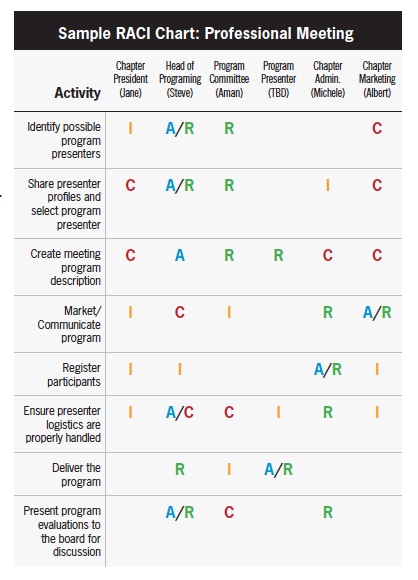
Have you ever been part of a team when no one knows what anyone else is doing? Maybe you find your efforts are duplicated or key activities fall through the cracks. Perhaps you think you are in charge—and then find out you don’t have the authority you need.
These are common team problems often caused by ambiguous roles and responsibilities. Clear and conflict-free roles enable team members to work together. When this is not the case, a team has significant problems that need to be resolved.
A RACI chart is a powerful project management tool that clarifies roles, responsibilities, and accountabilities, resulting in improved team performance.
HOW DOES IT WORK?
A RACI chart maps who does what, and with what authority, against key responsibilities or activities. The information in the RACI chart then becomes a discussion tool to clarify roles and responsibilities, and make visible who has the authority to sign off on each step or on the overall project. Four major roles—R A C I—need to be fulfilled:
R: Responsible: The person who does the work.
A: Accountable: This person makes the final decision and approves the step in the project plan (or approves the overall effort).
C: Consulted: This person provides information or advice to people who are responsible or accountable. They provide their input, help, or advice before the fact.
I: Informed: This person is informed about results and decisions after the fact.
To create the RACI chart, you create a matrix. On the left axis, list the steps in the project from the top down, starting with the first step. Across the top of the matrix, list each role and the name of the person who fills the role.
Here is a simple example in which a professional organization is setting up a chapter meeting with an external speaker:

RACI can be used diagnostically to identify the following typical team performance problems:
- Too many chiefs and no one doing the work: You see multiple As and no Rs horizontally across the chart for each activity.
- No one to approve or sign off on the step: A key activity has no assigned A.
- Lack of accountability: Several As are assigned to an activity, but no one is ultimately responsible.
- Too many people working on a single task: The activity has too many Rs assigned to it.
- One person is doing all the work: No one else has an R.
- Inadequate communication: There are few Cs or Is anywhere on the chart.
- Bureaucratic stasis: There are too many Cs and Is throughout the chart.
Ross Tartell, Ph.D., is currently adjunct associate professor of Psychology and Education at Columbia University. Dr. Tartell also consults in the areas of learning and development, talent planning, and organization development. He received his M.B.A. in Management and his Ph.D. in Social Psychology from Columbia University. He formerly served as Technical Training and Communications Manager – North America at GE Capital Real Estate.

